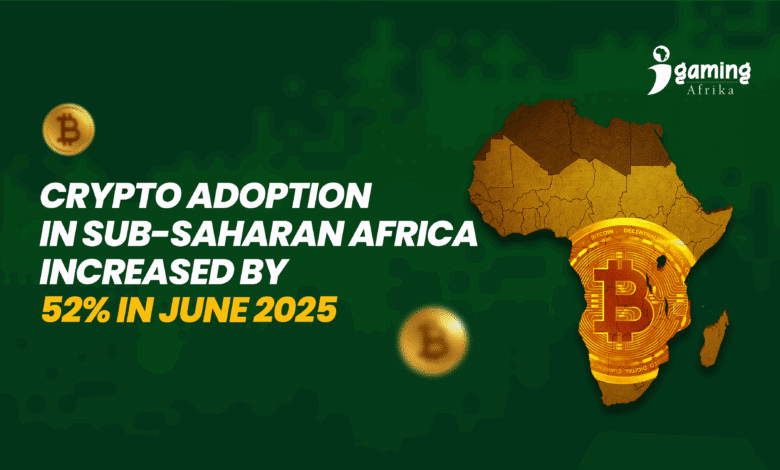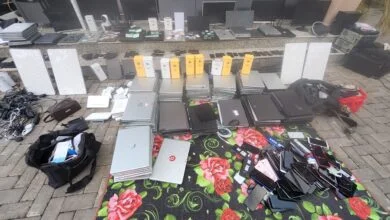
Sub-Saharan Africa experienced a 52% year-over-year increase in on-chain crypto activity in the 12 months ending June 2025, as per the Chainalysis Global Crypto Adoption Index report. This underscores the region’s increasing dependence on digital assets for financial access, routine payments, and remittances.
This increase is indicative of the continent’s distinctive status as one of the most dynamic crypto markets in the world, where practical utility continues to drive adoption.
The financial landscape of the region, which is home to several high-ranking nations on the Global Adoption Index, is unquestionably being transformed by cryptocurrency. A substantial number of Africans are progressively utilizing cryptocurrency for business payments, as a hedge against inflation, and for more frequent, smaller transfers.
Nigeria and South Africa are pioneering the development of blockchain-based solutions, peer-to-peer transactions, and trading volumes. These nations are experiencing accelerated adoption of crypto as a complement to conventional finance systems as a result of their high engagement levels and progressive regulatory initiatives.
In 2023, Sub-Saharan Africa received $54 billion in remittances, according to the World Bank. However, the cost of sending money to the region remains the highest globally, with an average fee of 7.9 percent for a $200 transmission.. Digital assets have become an appealing remedy due to these systemic frictions.
The world’s most expensive region for remittances, Africans are increasingly utilizing cryptocurrencies to circumvent the high fees associated with traditional remittance services, which can cost up to 7-10% of the transfer amount. Cryptocurrency provides a more cost-effective and expedited alternative.
Read Also: Africa: iGaming’s Next Frontier
The Asia-Pacific (APAC) region has emerged as the fastest-growing market worldwide, with crypto transaction volume increasing by 69% year-over-year, from $1.4 trillion to $2.36 trillion. Sub-Saharan Africa has experienced impressive growth in crypto adoption. Robust engagement in significant markets, including India, Vietnam, and Pakistan, was the driving force behind this accelerated expansion.
Latin America experienced a 63% increase, which is indicative of the increasing adoption of the technology in both the retail and institutional sectors, closely following APAC. These trends emphasize a global shift in crypto momentum toward the Global South, where on-the-ground financial use cases such as inflation hedging, cross-border payments, and access to decentralized finance (DeFi) are gaining traction.
Despite a slower tempo of adoption in comparison to other emerging markets, the Middle East and North Africa (MENA) region experienced a more moderate 33% growth, with total crypto transaction volumes still surpassing half a trillion dollars. This growth is a significant acceleration in nearly every region when compared to the previous year.
For example, APAC experienced a growth rate of 69%, which is more than double the rate of 27% from the previous year. Similarly, Latin America experienced a growth rate of 63%, which further solidified its status as one of the most significant centers for crypto expansion. Rapid gains were also observed in Europe and Sub-Saharan Africa, which is indicative of a widespread global expansion of digital assets.
Interesting, North America also experienced a growth spurt, increasing from 42% to 49%. This suggests that the regulatory clarity and institutional inflows of 2025 are now translating into measurable increases in transaction activity.
It is important to note that stablecoins are gathering momentum as they continue to expand globally for a variety of applications. In economies that are susceptible to inflation and currency volatility, numerous individuals are employing it for cross-border remittances, savings, and commerce. Chainalysis reports that stablecoins now comprise approximately 43% of the total crypto transaction volume in Sub-Saharan Africa, which is indicative of their expanding market share and capacity to reduce remittance expenses.
A look at on-chain data, reveals that stablecoin transaction volume remains dominated by USDT (Tether) and USDC, which consistently dwarf other stablecoins in scale. It is important to note that governments are concurrently investigating the development of their own digital currencies and the enhancement of their payment infrastructure as part of a broader modernization trend.
In order to improve financial inclusion and monetary sovereignty, central banks in numerous African countries have either contemplated or piloted central bank digital currencies (CBDCs). The Central Bank of Nigeria (CBN) has introduced cNGN, its inaugural regulated stablecoin, which is pegged 1:1 to the Nigerian Naira.
Despite the ongoing expansion of crypto adoption, the trajectory of Sub-Saharan Africa remains particularly significant, demonstrating the increasing importance of digital assets in the region’s economic empowerment and financial inclusion.





















